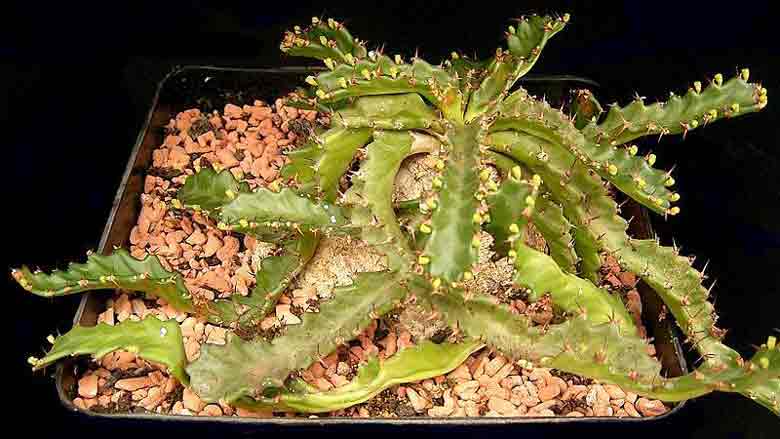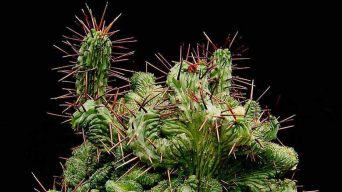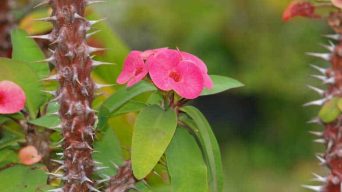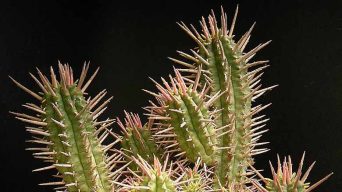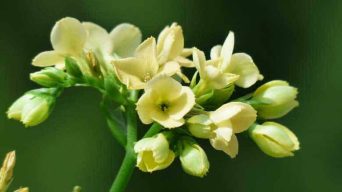The Euphorbia stellata is a succulent plant that is often used in landscaping and as a decorative item.
It is easy to propagate and care for, making it a good choice for any type of gardener.
This article will help you learn everything about Euphorbia stellata care and propagation so that you can create your own beautiful garden!
Overview
The Euphorbia stellata succulents are a type of flowering plant in the Euphorbiaceae family native to South Africa.
This Euphorbia species has a tree-like base with large stems coming out of it. It can reach up to just over 15 cm (6″) in height and around 7.5 cm (3″) in diameter.
This succulent blooms in the spring and summer, producing small, green-yellow flowers on its stem.
How To Care for Euphorbia Stellata
Euphorbia stellata care is not difficult. It is a species that adapts to many types of conditions and does well in most environments.
The following are the most important points to take care of Euphorbia stellata succulent plants.
Sun Exposure & Light Requirements
The Euphorbia stellata plants prefer full sun to partial shade.
They require at least six hours of sun exposure and bright light.
When growing Euphorbia stellata succulents indoors, placing them in a location that gets plenty of light is essential.
Somewhere like a large window with an east or west orientation is best suited for the Euphorbia stellata care.
However, it may need some shade outdoors because it can get too hot to grow when exposed to direct sunlight all day.
When shaded from intense sunlight, Euphorbias thrive while still receiving plenty of light and warmth for growth.
Watering Requirements
Watering the Euphorbia stellata is really easy. They need to be watered sparingly and only when the soil is dry.
Water every few days or once a week (depending on how hot it gets in your region) to ensure the soil is dry.
A good rule of thumb is to wait until one-third of the topsoil has dried before watering again.
Water thoroughly and make sure that the entire root system is watered.
Soil Requirements
The Euphorbia stellata succulent plant grows best in dry, porous soils with good drainage.
These plants grow best when planted in cactus soil or another type of potting mix that consists mostly of sand.
You can also mix in a handful of gravel, which will provide good drainage.
Avoid using heavy or clay-based soils such as red clays and those made from peat moss because they hold too much water and don’t allow the soil to dry out enough for this succulent plant to thrive.
Temperature and Humidity
Euphorbia stellata needs a temperature of between 18°C and 27°C (64°F -80°F).
This Euphorbia species prefers the humidity to be about 40 to 60%.
It mustn’t dry out or get too wet, so make sure you keep an eye on this while looking after your plant.
However, if the air in your home becomes very humid for long periods, there is less chance that the Euphorbias will need watering.
Fertilizing
The Euphorbia stellata succulent plant does not need to be fertilized too often.
You can fertilize it with a half strength diluted liquid fertilizer every month or two.
Avoid fertilizing in hot weather because that will cause burning and browning of the leaves, which is often irreversible damage!
Potting and Repotting
The Euphorbia stellata is a succulent plant that will need to be repotted periodically as it grows.
The potting and repotting process is straightforward, but it can be time-consuming.
The Euphorbia stellata will need to be repotted when it’s grown out of its current container or every two to three years.
The Euphorbia prefers being in a pot with plenty of room for the roots to grow and doesn’t dry out too quickly.
Pruning
It will need periodic trimming throughout its lifespan to maintain its health and improve the appearance of the Euphorbia stellata.
You can do this by cutting off dead or dying leaves and removing the lower stems of the Euphorbia plant that no longer has live roots.
You should also remove any discolored leaves or look like they might have been infected with some kind of disease.
However, other than for aesthetic purposes and to maintain the health of your Euphorbia stellata plant’s health, pruning too much is not recommended.
You may end up removing flower buds, which will then cause your Euphorbia to stop growing altogether.
Pests and Diseases
The Euphorbia stellata is not prone to many pests or diseases.
It may be vulnerable to aphids, mealybugs, and spider mites, which can all cause leaves to wilt and die back if left untreated.
The best action against these is insecticidal soap spray in the early stages, followed by neem oil as a systemic treatment for pests that have already established themselves on your plant.
Root rot can also be a problem. The best course of treatment is prevention by ensuring the plant’s soil drains freely and providing plenty of airflow around the roots.
If you catch root rot early enough, remove the affected soil and replace it with fresh. If left untreated, it can progress to a point where the plant’s growth is stunted or halted altogether.
How to Care for Euphorbia Stellata in Winter
Euphorbia stellata care in winter is pretty simple but requires some attention.
When Euphorbia stellata care involves cold weather, one of the biggest threats is frost or desiccation.
If you notice either of these things happening, it may be necessary to take action immediately by bringing euphorbias inside for protection from drafts and nighttime lows that often go below 55°F, even indoors.
It can also prove helpful to cover them up with an old sheet or other cloth to provide additional insulation from drafts and keep Euphorbia stellata warmer throughout the day.
If the Euphorbia is outside, it may also be a good idea to cover up any nearby trees or shrubs with fabric to protect them as well.
How To Propagate Euphorbia Stellata
The Euphorbia stellata can be propagated by cuttings, offsets, and seeds.
Cuttings
Cut the stem from an established Euphorbia stellata plant to take a cutting.
Allow the cut end to callous for a few days, and then use a rooting hormone to coat the end of the cut.
Insert into potting soil and keep moist. The cutting will root in about two weeks under proper conditions.
Once the cuttings have rooted, you can transplant them to a larger pot. The propagated Euphorbia stellata plant will need extra care until it becomes established in its new home.
Offsets
To propagate Euphorbia stellata by offsets, find an offset that is growing well. Cut about two inches below the offset with pruning shears or clippers.
Allow it to callous for another few days before inserting it into the soil. The offsets will root in about six weeks under proper conditions.
Once they have rooted, you can transplant them back into their original pot or move on to larger pots if necessary.
Offsets are a straightforward and efficient way of propagating Euphorbia stellata plants as long as enough healthy ones are available for cuttings!
Seeds
Euphorbia stellata seeds can be collected by clipping the seed heads and letting them dry.
Use a paper bag or sock to collect the seeds as they fall from the plant, then store them in an airtight container until it is time for planting.
Fill a shallow pot with well-draining soil mix and sprinkle Euphorbia stellata seeds on top of the surface before covering it with additional mix.
Keep moist but not wet while waiting for germination (usually takes about two weeks).
Once sprouted, keep young plants under bright light indoors or outdoors.
Once plants are established in their new homes, transplant into larger pots when necessary.
Is the Euphorbia Stellata Toxic?
The Euphorbia stellata can be toxic to pets and humans if ingested and can also cause skin irritation.
The Euphorbia stellata can produce a milky sap that deters predators and humans alike from eating its leaves or flowers.
This sticky substance can cause skin irritation if touched with bare hands, so be sure to wash after handling them!
If you have children or pets, this is not the plant for your home.
Final Thoughts
Euphorbia stellata is a relatively easy succulent to care for.
This Euphorbia species is a member of the Spurge family with a unique leaf structure, making it a great addition to any garden or container.
Understanding how to take care of and propagate this plant will help you make it thrive in your garden or home.
However, it is also important to note that Euphorbias are toxic and should be handled with care.

